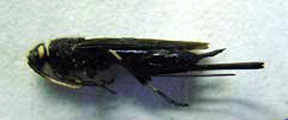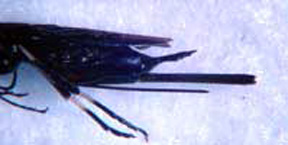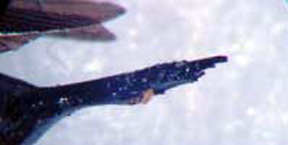A lesson in woodwasp identification
Editor’s note: This article is from the archives of the MSU Crop Advisory Team Alerts. Check the label of any pesticide referenced to ensure your use is included.
With all the excitement surrounding the recent find of a single European woodwasp, Sirex noctilio (Hymenoptera: Siricidae) in a trap in Macomb County, I think a little lesson in woodwasp identification may be in order.
Woodwasps belong to order Hymenoptera and are related to sawflies, bees, wasps and ants. Woodwasps belong to the suborder Symphyta, which includes our numerous sawfly plant pests. Like the sawflies, woodwasps do not have constricted waists like bees, wasps and ants. The abdomen and thorax of sawflies and woodwasps are “broadly joined” (like mine is). Woodwasps or siricids are also known as horntails because they have a spear-like spine, called a cornus, at the end of their abdomens. The presence of a cornus separates siricids from the other families in the suborder Symphyta. A female woodwasp, which is more likely to be encountered by the general public, also has a long needle-like ovipositor. So, a female siricid woodwasp will have two pointy structures at the end her abdomen.
The most common woodwasp submitted to the lab over the years has been the Pigeon tremex, Tremex Columba. In fact, I think this has been the only siricid species that has been sent in for identification prior to the discovery of Sirex noctilio. Recently, we got in a woodwasp known as the Whitehorned horntail, Urocerus albicornis, which is shown in the accompanying photos. It’s called the whitehorned horntail because of its white marked antennae. The antennae of Sirex noctilio are entirely black.
If you think you have found a European woodwasp and would like it identified, you can send it to Diagnostic Services and we will look at it at no charge.



 Print
Print Email
Email






